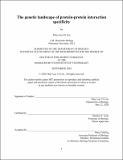| dc.contributor.advisor | Michael T. Laub. | en_US |
| dc.contributor.author | Lite, Thúy-Lan Võ. | en_US |
| dc.contributor.other | Massachusetts Institute of Technology. Department of Biology. | en_US |
| dc.date.accessioned | 2021-01-05T23:14:24Z | |
| dc.date.available | 2021-01-05T23:14:24Z | |
| dc.date.copyright | 2020 | en_US |
| dc.date.issued | 2020 | en_US |
| dc.identifier.uri | https://hdl.handle.net/1721.1/129035 | |
| dc.description | Thesis: Ph. D., Massachusetts Institute of Technology, Department of Biology, 2020 | en_US |
| dc.description | Cataloged from student-submitted PDF of thesis. | en_US |
| dc.description | Includes bibliographical references. | en_US |
| dc.description.abstract | Protein-protein interaction specificity is often encoded at the primary sequence level, and by just a few interfacial residues. Collectively, these residues have both positive and negative roles, promoting a desired, cognate interaction and preventing non-cognate interactions, respectively. However, for most protein-protein interactions, the contributions of individual specificity residues are poorly understood and often obscured by robustness and degeneracy of protein interfaces. Using bacterial toxin-antitoxin systems as a model, we use a variant of deep mutational scanning to dissect the positive and negative contributions of antitoxin residues that dictate toxin specificity. By screening a combinatorially complete library of antitoxin variants, we uncover a distribution of fitness effects for individual interface mutations measured across hundreds of genetic backgrounds. We show that positive and negative contributions to specificity are neither inherently coupled nor mutually exclusive. Further, we argue that the wild-type antitoxin may be optimized for specificity, because mutations that further destabilize the non-cognate interaction also weaken the cognate interaction. No mutations strengthen the cognate interaction. By comparing crystal structures of paralogous complexes, we provide a structural rationale for all of these observations. Finally, we use a library approach to identify hundreds of novel systems that are insulated from their parental systems, and that carry only two mutations - a negative specificity element on the toxin, and one on the antitoxin. This result demonstrates that highly similar (and in this case, nearly identical) complexes can be insulated using compensatory mutations of individually large effect. Collectively, this work provides a generalizable approach to understanding the logic of molecular recognition. | en_US |
| dc.description.statementofresponsibility | by Thúy-Lan Võ Lite. | en_US |
| dc.format.extent | 109 ages | en_US |
| dc.language.iso | eng | en_US |
| dc.publisher | Massachusetts Institute of Technology | en_US |
| dc.rights | MIT theses may be protected by copyright. Please reuse MIT thesis content according to the MIT Libraries Permissions Policy, which is available through the URL provided. | en_US |
| dc.rights.uri | http://dspace.mit.edu/handle/1721.1/7582 | en_US |
| dc.subject | Biology. | en_US |
| dc.title | The genetic landscape of protein-protein interaction specificity | en_US |
| dc.type | Thesis | en_US |
| dc.description.degree | Ph. D. | en_US |
| dc.contributor.department | Massachusetts Institute of Technology. Department of Biology | en_US |
| dc.identifier.oclc | 1200498190 | en_US |
| dc.description.collection | Ph.D. Massachusetts Institute of Technology, Department of Biology | en_US |
| dspace.imported | 2021-01-05T23:14:23Z | en_US |
| mit.thesis.degree | Doctoral | en_US |
| mit.thesis.department | Bio | en_US |
